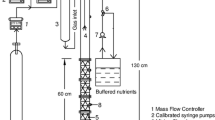Abstract
A two-phase partitioning bioreactor (TPPB) achievedsimultaneous and continuous removal and degradation of benzene and toluene froman air stream. The aqueous-organic system utilized n-hexadecane as the organicphase, and the organism Alcaligenes xylosoxidans Y234 in the aqueous phaseto achieve the degradation of benzene and toluene. The system, which operates asa well-mixed dispersion and is therefore resistant to substrate surges, was firstshown to be capable of utilizing toluene while operating at a loading capacity of 235 g m-3 h-1with an elimination capacity of 233 g m-3 h-1. It was also determined that to characterize TPPB performance in terms of elimination capacity thedefinition of elimination capacity must be extended to include the cell mass present, a readilycontrollable variable given the nature of the system. Based on this criterion, it wasestimated that for a cell concentration of 1 g l-1 present in the TPPB, thepotential maximum toluene elimination capacity is 1290 g m-3 h-1 whichis substantially higher than any toluene elimination capacity achieved by biofiltersat a high removal efficiency. If no other factor were to limit the system, eliminationcapacities could be many times higher still, and are dependent on maintaining desiredcell concentrations above 1 g l-1. The TPPB was then operated at nominalloading capacities of 63 g m-3h-1 (benzene) and 51 g m-3 h-1 (toluene) at a removal efficiency greater than 99% to demonstratedthe applicability of this system in dealing with two chemical species simultaneously. TPPBsystems therefore have been shown to be effective at removing gaseous organiccontaminants at high removal efficiencies while also possessing desirable operatingfeatures, such as providing and maintaining high cell concentrations throughout thereactor, and a capacity to effectively deal with high contaminant loadings.
Similar content being viewed by others
References
Abumaizar RJ, Smith EH & Kocher W (1997) Analytical model of dual-media biofilter for removal of organic air pollutants. J. Environ. Eng. 123: 606–614
Auria R, Frere G, Morales M, Acuna ME & Revah S (2000) Influence of mixing and water addition on the removal rate of toluene vapors in a biofilter. Biotechnol. Bioeng. 68: 448–455
Collins LD & Daugulis AJ (1996) Use of a two-phase partitioning bioreactor for the biodegradation of phenol. Biotechnol. Techniques 10: 643–648
Collins LD & Daugulis AJ (1997a) Biodegradation of phenol at high initial concentrations in two-phase partitioning batch and fed-batch bioreactors. Biotechnol. Bioeng. 55: 155–161
Collins LD & Daugulis AJ (1997b) Characterization and optimization of a two-phase partitioning bioreactor for the biodegradation of phenol. Appl. Microbiol. Biotechnol. 48: 18–22
Collins LD & Daugulis AJ (1999a) Benzene/toluene/p-xylene degradation part 1. Solvent selection and toluene degradation in a two-phase partitioning bioreactor. Appl. Microbiol. Biotechnol. 52: 354–359
Collins LD & Daugulis AJ (1999b) Simultaneous biodegradation of benzene, toluene, and p-xylene in a two-phase partitioning bioreactor: Concept demonstration and practical application. Biotechnol. Progress 15(1): 74–80
Cox HJ, Nguyen TT & Deshusses MA (2000) Toluene degradation in the recycle liquid of biotrickling filters for air pollution control. Appl. Microbiol. Biotechnol. 54: 133–137
Daugulis AJ (2001) Two-phase partitioning bioreactors: A new technology platform for destroying xenobiotics. Trends Biotechnol. 19: 459–464
Davidson, CT & Daugulis AJ (2003) The treatment of gaseous benzene by two-phase partitioning bioreactors: A high performance alternative to the use of biofilters Appl. Microbiol. Biotechnol. 62: 297–301
Deshusses MA (1997) Biological waste air treatment in biofilters. Current Opin. Biotechnol. 8: 335–339
Deshusses MA, Devinny JS & Webster TS (1999) Biofiltration for Air Pollution Control. Lewis Publishers, New York.
Deshusses MA & Johnson CT (2000) Development and validation of a simple protocol to rapidly determine the performance of biofilters for VOC treatment. Environ. Sci. Technol. 34: 461–467
Guieysse B, Cirne M & Mattiasson B (2001) Microbial degradation of phenanthrene and pyrene in a two-liquid phase-partitioning bioreactor. Appl. Microbiol. Biotechnol. 56: 796–802
Janikowski TB, Velicogna D, Punt M & Daugulis AJ (2002) Use of a two-phase partitioning bioreactor for degrading polycyclic aromatic hydrocarbons by a Sphingomonas sp. Appl. Microbiol. Biotechnol. 59: 368–376
Marcoux J, Deziel E, Villemur R, Lepine F, Bisaillon JG & Beaudet R (2000) Optimization of high-molecular-weight polycyclic aromatic hydrocarbons' degradation in a two-liquid-phase bioreactor. J. Appl. Microbiol. 88: 655–662
Matteau Y & Ramsay B (1997) Activated compost biofiltration of toluene. Biodegradation 8: 135–141
Munro DR & Daugulis AJ (1997) The isolation of a degradation intermediate during the biphasic fermentation of pentachlorophenol. Res. Environ. Biotechnol. 2: 1–18
McNevin D & Barford J (2000) Biofiltration as an odour abatement strategy. Biochem. Eng. J. 5: 231–242
Ortega-Calvo JJ, Birman I & Alexander M (1995) Effect of varying the rate of the partitioning of phenanthrene in nonaqueous-phase liquids on biodegradation in soil slurries. Environ. Sci. Technol. 29: 2222–2225
Vrionis HA, Kropinski AMB & Daugulis AJ (2002) enhancement of a two-phase partitioning bioreactor system by catalyst modification: demonstration of concept. Biotechnol. Bioeng. 79: 587–594
Yeom SH (1998) PhD Thesis: Biodegradation of BTX in a hybrid bioreactor. Department of Chemical Engineering, Graduate School Seoul National University.
Yeom SH, Dalm MCF & Daugulis AJ (2000) Treatment of high-concentration gaseous benzene streams using a novel bioreactor system. Biotechnol. Lett. 22: 1747–1751
Yeom SH & Daugulis AJ (2001) Benzene degradation in a twophase bioreactor by Alcaligenes xylosoxidans Y234. Process Biochem. 36: 765–772
Author information
Authors and Affiliations
Corresponding author
Rights and permissions
About this article
Cite this article
Davidson, C.T., Daugulis, A.J. Addressing biofilter limitations: A two-phase partitioning bioreactor process for the treatment of benzene and toluene contaminated gas streams. Biodegradation 14, 415–421 (2003). https://doi.org/10.1023/A:1027363526518
Issue Date:
DOI: https://doi.org/10.1023/A:1027363526518




